What would happen if powerful megacorporations gained complete control over the world’s governments? When the wealthy are untouchable and care only about themselves, and the middle-class are struggling just to maintain their position, what will become of the poor unwashed masses? Will they forever be controlled by the corporate sponsored military police that roam the streets? This is the question often posed by the sci-fi genre known as cyberpunk, and this is the setting of Satellite Reign, a new game now available on Steam’s early access program from developer 5 Lives Studios.
We first learned of Satellite Reign back in the summer of 2013 when they ran a quite successful Kickstarter campaign. While it doesn’t openly claim to be a successor to the popular Syndicate series from Bullfrog, the campaign also made sure it was no secret that the creator of Syndicate Wars was behind this project. After roughly a year and half, the game arrived in a “pre-alpha” state just before 2014 came to a close.
Many features have not yet been implemented, the game still needs optimization, and numerous bugs are likely to occur. Still, I expect many are curious about how the game is shaping up. After several hours with the current version, I’m ready to share some first impressions and hopefully help you decide if this is a game you will want to keep your eye on or not.
Early Access Impressions
Satellite Reign is a real-time strategy, squad based, cyberpunk game set in a large metropolis. The city provides an open-world for you to explore, and the developers state this world is “designed around emergent gameplay.” You’ll be exploring this city with a 4 person squad made up of a soldier, a support, a hacker, and an infiltrator. Throughout the game, you’ll be participating in activities befitting of the cyberpunk world you find yourself in. Bribery, theft, hacking, hijacking, and murder, to name a few. You’ll also acquire new weapons and new skills to help you succeed in these tasks.
It’s a game that requires a willingness to accept the chaos that will undoubtedly ensue. This is a real-time game with no pause button (other than the menu screen). While many have asked for such a feature in the game’s forums, the developers have repeatedly stated that real-time only is here to stay. This means coordinated strikes, firefights, and stealth can be quite challenging, and sometimes frustrating, to pull off. It also means it can be quite intense, exciting, and nerve racking as you respond quickly to changing situations and threats. While there is a slow-time ability, which I’ll get into later, it doesn’t really change much in my opinion. Basically, if you don’t take pleasure in RTS games, it’s likely best you sit this one out unless the developers some day have a change of heart.
With a cyberpunk game like this one, I think it’s important to discuss the setting. I feel like they’re doing a great job with it so far. The game currently has 1 (of its eventual 4) districts available, the downtown district. In this district there are shady bars and clubs, hovercars, holographic images, electronic billboards, random citizens roaming the streets, and corporate military police and drones keeping people “safe”. The sharp contrast of neon lights against the rain and darkness of night create a nice ambiance that fits the genre. Unfortunately, the game does suffer from some framerate issues at this point, and this hinders my ability to see the game play out as fluidly as I would like.
Wait There Are Missions?
While you can wander around the map shooting people as much as you’d like, the real objective of the game at this point is to complete missions. These missions can be completed in any order you choose, but the first one involves rescuing your 4th agent, the soldier, so it is advisable to do it right away. There are slightly over a half dozen or so missions at this point, with some containing optional sub-objectives.
The missions each contain a generally interesting summary that feels firmly planted in the cyberpunk world you find yourself in. In addition, they provide some very useful information regarding what you will be facing and why it is imperative that you complete them. Should you want even more information, many offer a bribe option that for a small fee will provide additional intel regarding obstacles you may face and how to circumvent them. The one issue I have with the summaries right now is the text size. It’s quite small and feels a bit cramped. I can see people having issues reading the small green text on the black background.
You won’t be wandering around forever looking for the mission objectives, as a convenient ping system shows you on your map where to head. The trick is rather how you’re going to get to them. The missions, while different, essentially all involve breaking and entering jobs, at least at this point. You’ll be trying to reach a specific entry point of a well-defended compound and have one of your agents, sometimes a specific one, enter it. While this is somewhat disappointing, the fact that each offers a few different approaches allows you to maintain interest, at least for the few missions currently available. On a more positive note, each mission grants district wide bonuses to your agents or penalties to your enemies. This helps make your actions feel more meaningful in the context of the game.
Accessorizing Your Agents
The game includes a lot of options to advance your agents and their abilities, and this leads me to believe that tougher challenges are certainly ahead. Starting with the most basic upgrades, as you complete missions, you can collect prototype weapons. These weapons can then be equipped, or better yet, researched in order to unlock them as purchasable weapons for all your agents. Research is fairly simple and performed through a menu option. To perform research, you select how many researchers you want to assign to the job. This equates to how much money you want to spend to get it done faster. Then you go about your business while you wait for it to finish up.
While weapons are great to have and I’m sure new and more powerful ones are still on the way, another option coming down the road is the ability to augment your agents with enhancements. It appears augmentations to the head, body, arms, and legs will be available for each of your agents in the future. I don’t know much more about these at this point.
One element already in the game is agent skills. Each agent has a set of skills that can be increased as they level up. While agents do share some basic skills such as weapon skill and health upgrades, they also each have their own unique skills. Skills are defined between active skills, skills that use up energy when used, and passive skills like additional health that are always in effect. As far as unique skills go, the infiltrator for instance can unlock cloaking, melee kills, and a master thief skill that helps him infiltrate structures by riding down ziplines. The hacker can improve hacking in order to open doors, shutdown cameras, and hack ATM machines to steal cash. The soldier can absorb more damage, and the support can scan areas for enemies, heal nearby agents, and slow down time.
One disappointing aspect of the skills, though this may be a pre-alpha issue, is that experience points seem to only be earned when killing enemies. Hacking targets for instance does not gain the hacker experience. This means to increase hacking, you need to essentially have your hacker kill more. It’s certainly not a deal breaker if it stays this way, but I know I’d prefer to be able to gain experience in tasks by using the abilities effectively in addition to combat. Going in guns blazing shouldn’t always be the correct method of advancement, but at this point it feels suboptimal to do anything else.
A Simple Plan
I don’t often play RTS games that don’t offer a pause button, and this alone left me feeling a bit out of my depths at times. While the game will more or less proceed at your own pace as you wander the city, when you do decide it’s time to take an action that will put your agents at risk, time quickly becomes of the essence. This is best described with a brief story of my typical mission experience.
My agents approach a well protected compound. The pavement is printed with the words “restricted area”, and crossing the line will anger the soldiers patrolling the area. We (my agents) continue walking past the entrance with our weapons concealed. We’ve bribed someone who has informed us of a side entrance that is more loosely guarded. We decide this is the best approach.
We come across an unguarded locked door at the side entrance with a nearby control panel. Our hacker unlocks it. The agents move through the door and take up defensive positions behind cover. Ahead, a lone camera sweeps across the only entry to the compound. We have a few options. We can try to time it and run past as it sweeps the other way, shoot it causing guards to show up, hack the console nearby to temporarily disable it, or our infiltrator can cloak by it and leave us behind. We decide to hack the cameras this time around.
As the hacker works on the control panel, we hear a guard radioing in behind us. We’ve been spotted. Before we can react, we’re in a firefight. Bullets fly as guards approach from multiple sides. Frantically, I hit hotkeys trying to highlight the correct agent and issue orders. Sometimes these don’t work and the agent isn’t selected. This is painful because agents don’t take cover or even return fire on their own consistently from my experience. I try to use my ability hotkey but the wrong agent is selected. As I select the right agent, he goes down from gunfire. Eventually we kill the guards with the remaining agents, one of which is barely clinging to life yet managed to get a melee kill off just before he died.
Our killed agent respawns after awhile at a spawn point we triggered a fair distance away from the compound. They rejoin us and we continue into the compound, forgoing stealth in favor of shooting everything that moves. Our agent runs to the objective as we provide cover fire. We then run out of the compound and hide while we wait for our “wanted” level to reduce so we can take on the next mission. We begin research of any prototype weapons and allocate skill points while we determine what mission we are going to tackle next.
Closing Thoughts
My first impressions of Satellite Reign are that it has left me wanting for more, but willing to wait. It’s got a great concept and setting for cyberpunk fans, and the beginnings of an interesting weapon/augmentation/skill system. When the game works, it works well. It’s at its absolute best when I am watching for patrols, hacking open doors, shooting out cameras, and positioning agents to flank enemies I’ve alerted to my position.
It’s also a pre-alpha with bugs everywhere, framerate issues, samey feeling missions, very small hard to read text, and unresponsive controls. While the game feels broad in its reach at this point, it feels shallow in its implementation. The framework of a lot of the features are in, and it looks great, but it is going to take time to fill everything in. As it stands now, there’s only a few hours of content in the game. I’m very interested to see how this one turns out once they’ve had a chance to finish implementing all they’ve got planned.

11 Comments
Related Articles:
- Satellite Reign Review
- Satellite Reign – Spiritual Successor to Syndicate Wars Funded
- Net Gain: Sabotage and Espionage in a Cyberpunk World
- Star Prospector – First Impressions
- XCOM: Enemy Unknown Slingshot DLC – Impressions

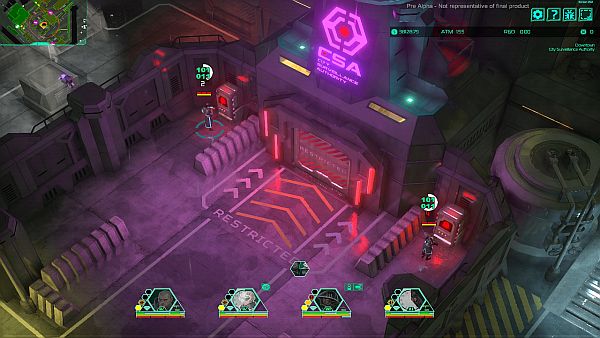
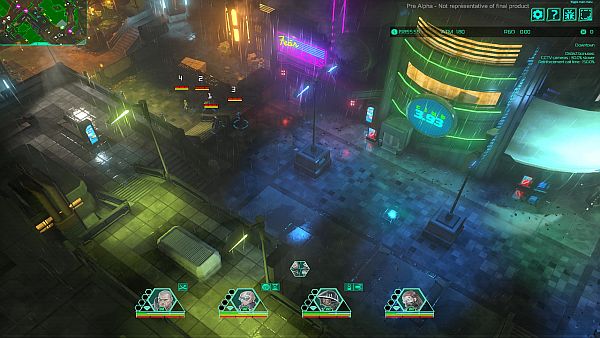
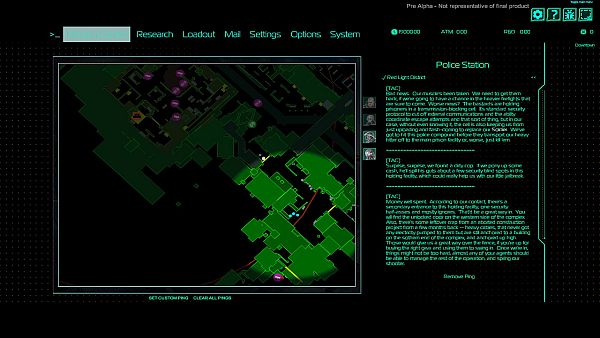
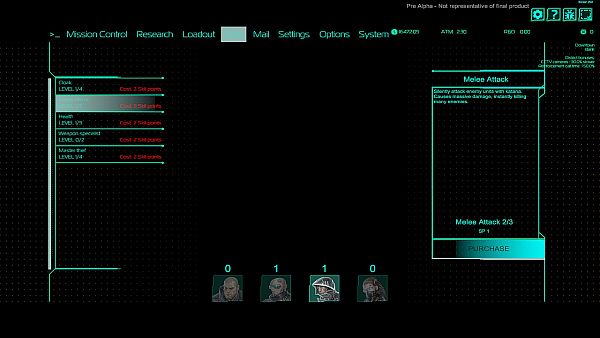
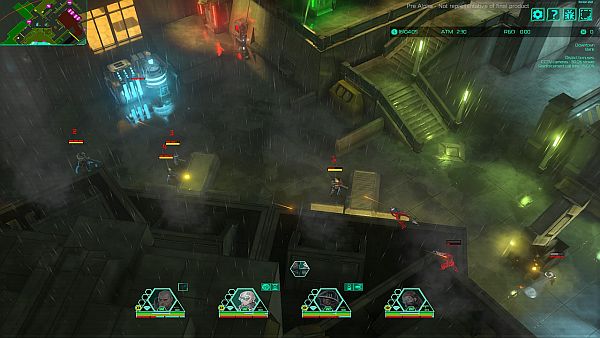






Great review! I’m confident based on your write-up and what I’ve seen on YT, the devs will make this game much better. At only 30 USD I might just pick it up today.
Now totally off topic and only a suggestion – as we get older, so goes our vision. Now I know I can adjust variables using my Web browser, but would you guys at least entertain adjusting text size and spacing on your pages? Right now, especially with long post like this one, everything is difficult to read.
As a Website developer, here’s a quick fix that I’m sure anyone, young or old, would appreciate:
Add this to your template CSS file:
.entry > p {
font-size: 14px;
line-height: 24px;
}
Obviously you can change the values but to me this not only makes the font size a bit more larger, but adjusting the line height makes the entire page look less crammed together.
The other minor quibble, when I log in to post, it takes me back to your landing page. Just a little annoying I have to find the article again.
I’ve increased the line-height a bit, I agree that it’s more readable this way. Let me know if it helped.
On the “log in->goes to landing page” issue, yeah, it can be annoying, I’ll look into that.
\Edit: “log in->goes to landing page” issue resolved. When a user logs in they do not go to the home page as before but to the post where they’ve logged in from. Also, you can always click “Remember Me” in the login screen for the site to log you in automatically, so that you can post comments without having to log in all the time.
I hope they get everything ironed out. I love Syndicate Wars. I’m not buying anymore early access titles but I’ll pick this up when / if it goes gold.
No pause button what the f***? I’ve heard all good stuffs about this classic series but never played them, so I’ve no expectations. Can’t be disappointed is such a good feeling nowadays…
The originals didn’t have pause I think – been too long since I last played Syndicate. Then again, most of the original’s mission were never more than blasting away with mini-guns.
It does seem strange for a modern game that advertises intricate tactical maneuvers in real time to omit a pause-order function. Unless the missions are heavily scripted like the Commandos series, I can’t imagine anything more intricate than cover-shoot-flank movements.
I see.
Could still be fun if the weapons/skills system are in depth I guess.
The engine and theme are great.It just needs a lot more development.
That’s a fair assessment. I just hope they don’t jump the gun and “release” before they finish doing so as that would be a real shame.
The problem for indies (okay, even for AAAs) is that usually the funds run out before the polish is complete.
However, unlike a established studio, indies just don’t have any other source of funding to work through unexpected cost overrun. It’s less “jumping the gun” and more how long the studio can afford to delay full release.
Maybe in the next interview with some indie studio, Spacesector can be blunt and ask how much money’s left from Kickstarter (hey, investors has the right to the financials right?) and will there be an EA just to put food on the table. =P
Very good points and very true based on what I’ve seen amongst many games hitting early access. Ambitious projects tend to require more funding than initially expected, and certainly more than is requested via Kickstarter.
In a way, this kind of mimics what many of the established studios have gone through. Many of these studios are living project to project even when funded by a publisher. The fact is many studios have trouble delivering on what their vision is within a reasonable time frame and budget. Having someone in a position of authority who is able to evaluate cost vs. benefit and cut out excess features that offer little return for the time/money spent is invaluable. Unfortunately a lot of indies just don’t have this guidance, and self regulating your ambitions (settling for less) is very difficult. Those that succeed in doing so tend to produce quality products though.
Most indie games on KS (honorable mention to Double Fine) has the business plans of a lemonade stand. Hmm, actually, a lemonade stand would require instant transfer of goods after payment…
The indies should be treating us like judges on Shark Tank than us treating them like saviors of mystical, long forgotten *insert PC genre*. =)